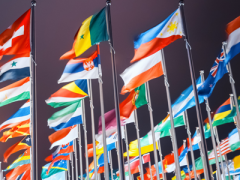The role of peatland degradation, protection, and restoration for climate change mitigation in the SSP scenarios
Peatland only covers a small fraction of the global land surface (∼3%) but store large amounts of carbon (∼600 GtC). Drainage of peatlands for agriculture results in the decomposition of organic matter, leading to greenhouse gas (GHG) emissions. As a result, degraded peatlands are currently responsible for 2%–3% of global anthropogenic emissions. Preventing further degradation of peatlands and restoration (i.e. rewetting) are therefore important for climate change mitigation. This study shows that land-use change in three SSP scenarios with optimistic, recent trends, and pessimistic assumptions leads to peatland degradation between 2020 and 2100 ranging from −7 to +10 Mha (−23% to +32%), and a continuation or even an increase in annual GHG emissions (−0.1 to +0.4 GtCO2-eq yr−1).
In default mitigation scenarios without a specific focus on peatlands, peatland degradation is reduced due to synergies with forest protection and afforestation policies. However, this still leaves large amounts of GHG emissions from degraded peatlands unabated, causing cumulative CO2 emissions from 2020 to 2100 in an SSP2-1.5 °C scenario of 73 GtCO2.
In a mitigation scenario with dedicated peatland restoration policy, GHG emissions from degraded peatlands can be reduced to nearly zero without major effects on projected land-use dynamics. This underlines the opportunity of peatland protection and restoration for climate change mitigation and the need to synergistically combine different land-based mitigation measures.
Peatland location and extent estimates vary widely in the literature; a sensitivity analysis implementing various spatial estimates shows that especially in tropical regions degraded peatland area and peatland emissions are highly uncertain. The required protection and mitigation efforts are geographically unequally distributed, with large concentrations of peatlands in Russia, Europe, North America, and Indonesia (33% of emission reductions are located in Indonesia). This indicates an important role for only a few countries that have the opportunity to protect and restore peatlands with global benefits for climate change mitigation.
Authors
Specifications
- Publication title
- The role of peatland degradation, protection and restoration for climate change mitigation in the SSP scenarios
- Publication date
- 30 May 2023
- Publication type
- Article
- Publication language
- English
- Magazine
- Environmental Research: Climate
- Issue
- Volume 2, Number 3
- Product number
- 5284




